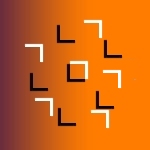
ISSN 2364-3641
Publications:
direct access:
vpl-reports.de
Open Access
| home | evaluation | archive | vpl-goettingen.de | impressum |
|
VPL-reports, 7, 1-22
The method of cued visual selection (CVS) was used to measure the identification speed of targets in different
surrounds. Local orientation contrast is known to modulate neural responses in the visual system; we should expect
targets with orientation contrast being faster identified than targets surrounded by similar lines. This was
confirmed in the data of five (of six) observers in the main experiment of the study. Performances were measured
with line arrays in which individual lines ("targets") were cued at various delays after stimulus onset. At all
tested cue delays from 100 ms to 5 s after stimulus onset, targets in popout configurations were faster identified
than cued targets in uniform configurations. At shorter delays (0 ms and 50 ms), differences were absent or not
significant. Targets in border-like configurations, which 37.5% of the orientation contrast of popout targets, were
identified at intermediate rates. Surrounds also affected the time course of growing target identification with
increasing presentation time (after the cue), basically confirming predictions made from neural population
responses at various delays after stimulus onset. The sixth subject behaved differently and produced opposite
results. It was conjectured that this might have been due to crowding and an inability to quickly identify targets
at the tested eccentricity. To test this hypothesis, this and two other subjects were tested in a modified
experiment, in which target eccentricity was reduced and cued targets were presented closer to the fixation spot.
This modification was sufficient to generate performance differences similar to those obtained with the other
observers in the main experiment. Altogether, the experiments have uncovered perceptual variations in target
identification that were predicted from neuronal response differences between uniform and popout targets. CVS has
thus been proven a useful method for looking into details of neural processing in the visual system with
psychophysical methods.
|
Download pdf ppt of figures Comments: |
©